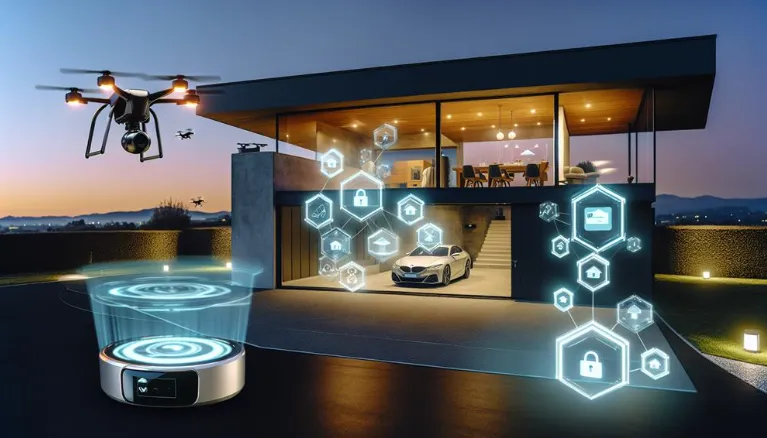The Future of Home Safety Smart Home Security Innovations

Imagine stepping into a world where your home automatically recognizes your face, alerts you to packages at your door, and even secures itself with a simple touch. The future of home safety lies in these smart home security innovations, leveraging AI, biometrics, and IoT for unparalleled protection. You’ll find AI-powered surveillance systems that adapt to your routine, smart doorbells with package detection, and biometric locks that ensure only authorized access. But these advancements also bring new challenges and considerations. So, what exactly does this mean for your everyday life and peace of mind?
Contents
AI-Powered Surveillance
Leveraging advanced algorithms, AI-powered surveillance systems can significantly enhance the accuracy and efficiency of home security by identifying potential threats in real-time. These systems utilize facial recognition technology to precisely identify individuals approaching or entering your home. By comparing captured images against a database of known faces, the AI can quickly determine whether someone is a friend, family member, or an unknown individual, thereby reducing the likelihood of false alarms.
Additionally, behavior analysis adds another layer of security. AI algorithms can monitor and interpret patterns of movement and behavior, flagging any anomalies. For instance, if someone is loitering near your property or attempting to access entry points in an unusual manner, the system alerts you immediately. This proactive approach not only boosts security but also provides peace of mind by ensuring that you’re notified of any suspicious activity before it escalates.
What sets AI-powered surveillance apart is its ability to learn and adapt over time. The more data it processes, the more accurate and efficient it becomes. This continuous improvement means your home security system is always evolving, staying one step ahead of potential threats.
Smart Doorbells
Smart doorbells have revolutionized home security by combining video surveillance, real-time alerts, and two-way communication into a single, user-friendly device. These doorbells allow you to monitor your front door from anywhere in the world via your smartphone. The integration of facial recognition technology enhances the user experience by distinguishing between family members, friends, and strangers, thus reducing false alarms.
From an industry perspective, the incorporation of AI-driven package detection addresses one of the most pressing issues in modern home security: package theft. When a delivery is detected, smart doorbells can immediately notify you, allowing you to take prompt action if necessary. This feature not only enhances security but also adds a layer of convenience, as you can verify deliveries remotely.
Furthermore, the two-way communication feature is invaluable for interacting with visitors or delivery personnel without ever opening the door. This functionality is particularly beneficial for those concerned about personal safety.
Advanced Alarm Systems
Advanced alarm systems have taken home security to the next level by integrating cutting-edge technologies like artificial intelligence, IoT connectivity, and real-time analytics to offer comprehensive protection.
You can now rely on wireless sensors that are strategically placed around your home, eliminating the need for cumbersome wiring and enabling flexible installations. These sensors detect unusual activities and instantly alert you and the monitoring center, ensuring quick response times.
Alarm customization is another game-changer, allowing you to tailor the system to your needs. You can set specific triggers for different types of alarms, such as distinguishing between a broken window and an opened door, which minimizes false alerts. Moreover, the integration of AI algorithms helps in recognizing patterns and reducing the chances of unnecessary alarms by understanding the normal activities within your home.
IoT connectivity enables seamless communication between various smart devices, ensuring that your alarm system is always in sync with other security components. For instance, if a wireless sensor detects motion, it can trigger cameras to start recording, lights to turn on, and even notify you via a mobile app. This interconnected approach maximizes security and provides you with peace of mind.
Biometric Locks
As alarm systems continue to evolve, biometric locks offer an additional layer of sophisticated security by using unique biological traits, such as fingerprints or facial recognition, to grant access. These systems provide unparalleled accuracy and convenience, leveraging advanced algorithms to ensure only authorized individuals can enter your home.
From a technical standpoint, biometric locks integrate seamlessly with existing security frameworks, enhancing both efficacy and user experience. Fingerprint sensors, facial authentication, and voice recognition are at the forefront of this technology.
Fingerprint sensors scan the unique patterns of your finger, while facial authentication uses complex algorithms to map and verify your facial features. Voice recognition, though less common in locks, is gaining traction for its non-contact convenience and versatility.
Industry insights suggest that the demand for biometric locks is rising due to their high security and ease of use. Unlike traditional keys or PIN codes, which can be lost or stolen, your biological traits are inherently more secure. Additionally, the latest models often include multi-factor authentication, combining two or more biometric methods for added security.
Investing in biometric locks not only bolsters your home’s defense but also modernizes it, aligning with contemporary trends in smart home technology.
Home Automation Integration
By seamlessly integrating with various smart devices, home automation systems offer a unified and efficient way to manage your home’s security and functionality. Through centralized control platforms, you can synchronize security cameras, smart locks, and alarm systems for an interconnected, responsive environment. This integration not only enhances security but also improves energy management by automating lighting and climate controls based on occupancy and time of day.
Voice assistants like Amazon Alexa and Google Assistant play a pivotal role in home automation. With simple voice commands, you can arm your security system, lock doors, or adjust settings for optimal energy efficiency. These voice-activated controls enable hands-free operation, providing convenience while ensuring that your home remains secure and energy-efficient.
Moreover, advanced home automation allows you to set up customized scenarios. For example, activating a ‘Goodnight’ command could lock all doors, turn off unnecessary lights, and adjust the thermostat to an energy-saving mode. This level of integration not only bolsters security but also contributes to significant energy savings over time.
In essence, home automation integration leverages cutting-edge technology to create a safer, more efficient living space, merging security and energy management into a cohesive, user-friendly system.
Cybersecurity Measures
Ensuring robust cybersecurity measures is crucial to safeguard your smart home devices from potential threats and vulnerabilities. As the number of connected devices in your home increases, so does the risk of cyber attacks.
Implementing network encryption is one of the most effective ways to protect your data. By encrypting your home network, you make it significantly harder for hackers to intercept and decipher the information being transmitted between your devices.
Device authentication is another essential layer of security. Each smart device in your home should have a unique identifier and require authentication before gaining access to your network. This prevents unauthorized devices from connecting and potentially compromising your entire system.
Look for devices that support robust authentication protocols, such as multi-factor authentication (MFA) or biometric verification.
It’s also important to keep your software and firmware up to date. Manufacturers regularly release updates that patch security vulnerabilities. Ignoring these updates can leave your devices exposed to cyber threats.
Regularly auditing your network for suspicious activity and vulnerabilities can help you stay ahead of potential risks. By prioritizing network encryption and device authentication, you can create a more secure and resilient smart home environment.
Remote Monitoring
While cybersecurity measures protect your smart home from digital threats, integrating remote monitoring systems allows you to maintain real-time awareness and control over your home environment. By leveraging advanced video streaming technologies, you can keep an eye on your property from virtually anywhere. High-definition cameras, equipped with night vision and motion detection, provide clear and continuous video feeds directly to your smartphone or tablet, ensuring you don’t miss a thing.
Remote monitoring doesn’t stop at just video streaming. The integration of mobile notifications ensures that you’re instantly alerted to any unusual activity. Whether it’s a door opening unexpectedly or motion detected in restricted areas, your system can send real-time alerts, enabling you to take immediate action. This proactive approach not only enhances security but also provides peace of mind, knowing your home is under constant watch.
Moreover, the analytics capabilities of these systems are evolving rapidly. Advanced algorithms can now differentiate between regular and suspicious movements, reducing false alarms and enhancing response accuracy.
Emergency Response Innovations
Revolutionizing home safety, emergency response innovations now integrate cutting-edge technology to drastically reduce response times and enhance situational awareness. You’ll find that modern systems utilize advanced sensors and AI to detect emergencies like fires, break-ins, or medical crises instantly. These systems automatically trigger emergency communication protocols, alerting both homeowners and emergency services in real time.
One of the most significant innovations is the smart hub, which serves as the central command for all your security devices. It can seamlessly coordinate with local emergency services, ensuring a rapid response. For example, if a smoke detector senses fire, the system not only sounds alarms but also sends critical data such as location and potential hazards to firefighters, allowing for a more efficient intervention.
Furthermore, advancements in GPS and IoT have made it possible to track the exact location of distress signals within your home. This precision assists emergency responders in navigating complex layouts quickly, saving valuable time.
Additionally, integrating video surveillance with emergency communication systems provides first responders with live feeds, offering real-time situational awareness. These innovations collectively enhance the effectiveness and speed of emergency responses, making your home significantly safer.
Conclusion
In the realm of home security, the adage ‘an ounce of prevention is worth a pound of cure’ holds true. By adopting AI-powered surveillance, biometric locks, and advanced alarm systems, you’re not just protecting your home—you’re investing in peace of mind.
Seamless integration and remote monitoring mean you can respond to threats promptly. Remember, a smart home doesn’t just react; it anticipates and prevents, ensuring your safety is always a step ahead.



